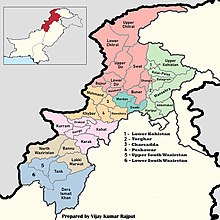Kohistan region, Pakistan
 From Wikipedia - Reading time: 6 min
From Wikipedia - Reading time: 6 min
Kohistan
کوہستان | |
|---|---|
| Province | |
| Area | |
• Total | 11,531 km2 (4,452 sq mi) |
| Demographics | |
| • Ethnic groups | Hazara Kohistanis, Torwali, Kalami, Shin, Tirahi, Swatis, Pashtuns |
| • Languages | Kohistani, Torwali, Kalami, Kohistani Shina, Pashto, Urdu |
| Time zone | Pakistan Standard Time |
| Largest cities | |
Kohistan is a mountainous region located in the northern Pakistan. It consists of Indus Kohistan, Swat Kohistan and Dir Kohistan in the Khyber Pakhtunkhwa province, with a total area of 11,531 square kilometres (4,452 sq mi).
History
[edit]Kohistan is home to a number of Indigenous northwestern Indo-Aryan peoples, collectively known as Kohistanis, who inhabited a larger region than their present extent in the past. The Gibari-speaking sultans of Swat controlled most of the present-day Swat, Malakand, Dir and Buner regions until the sixteenth century. Sultanate of Swat was invaded by the Yousafzai Pashtuns under the leadership of Malik Ahmed Baba between 1510 and 1515, who forced most of the Kohistanis to take refuge in the Swat Kohistan.[1]
The Pashtun migration, followed by the Pashtunization of the region, continued in the following centuries. In the early 20th century, Swat emerged as an autonomous state under the Miangul dynasty. Miangul Abdul Wadud undertook several campaigns against the Kohistanis of Shangla, Buner and Battagram, incorporating these tracts into his state. As a result, these districts have a Pashtun majority today due to the Pashtun settlements that were subsequently established.[2]
Kohistan region was part of Malakand and Hazara Tribal Agencies during the British colonial period. The Kalam tract was established as an independent tribal agency by the colonial government in 1926 due to the competing claims by the states of Chitral, Dir, and Swat. After the independence, however, the ruler of Swat annexed Kalam into Swat. It remained so until 1954, when it was agreed between the Government of Pakistan and Swat that Kalam would be de-jure part of Pakistan, nevertheless, the Wali of Swat would continue to administer it on the behalf of Pakistani government. Swat Kohistan became part of the newly created Swat District after the formal abolition of princely states in 1971.[3]
Geography
[edit]
Today, Kohistan refers to the narrow tract of land, divided among Swat, Dir and Indus Kohistan, where Kohistanis still form a majority. It is bounded by Chitral to the north, Afghanistan to the west, Gilgit Baltistan to the north and north-east and rest of Khyber Pakhtunkhwa to the south. Administratively, eastern Kohistan is divided into the districts of Upper Kohistan, Lower Kohistan and Kolai-Palas districts. The western Kohistan is divided into Sharingal and Behrain tehsils in the Upper Dir and Swat districts, respectively.[4]
Demographics
[edit]According to the 2023 Census of Pakistan, the Kohistan region had total population of 1,395,190. The region is rich in linguistic diversity. The dominant ethnic group are Kohistanis, comprising 64.26% of total population, followed by Pashtuns (17.89%), Torwalis and Kalami (10.11%) and Shinas (4.28%).[5]
Due to its historical and ethnical relations with the neighbouring Gilgit Baltistan, Kohistan as well as Chitral is claimed by the Gilgit Baltistan nationalists as part of the greater Gilgit Baltistan.[6]
Tourism
[edit]Kohistan is known for its scenery and contains large number of alpine valleys and glacier lakes. Some of the most popular tourist attractions of Kohistan region include Kumrat Valley, Kalam Valley, and Katora Lake.[citation needed] The region is transversed by several rivers, including Swat, Panjkora and Chitral.[7][8]
References
[edit]- ^ Arlinghaus, Joseph Theodore (1988). The Transformation of Afghan Tribal Society: Tribal Expansion, Mughal Imperialism and the Roshaniyya Insurrection, 1450–1600. Duke University. pp. 191–210.
- ^ Rome, Sultan-i (2008). Swat State, 1915–1969, From Genesis to Merger: An Analysis of Political, Administrative, Socio-Political, and Economic Development. Karachi: Oxford University Press. pp. 121–125. ISBN 0-19-547113-X.
- ^ Nasir, Fateh-Ul-Mulk Ali (July 11, 2020). "Kalam and the three princely states of Swat, Chitral and Dir". WeMountains. Retrieved September 14, 2024.
- ^ "Kohistan". Encyclopedia Britannica. Retrieved September 4, 2024.
- ^ a b "7th Population and Housing Census - Detailed Results: Table 11" (PDF). Pakistan Bureau of Statistics.
- ^ Dad, Aziz Ali (2016). Baldauf, Ingeborg; Conermann, Stephan; Kreutzmann, Hermann; Nadjmabadi, Shahnaz; Reetz, Dietrich; Schetter, Conrad; Sökefeld, Martin; Bech Hansen, Claus Erik; Hornidge, Anna-Katharina; Mielke, Katja; Nokkala, Nelli (eds.). "Boundaries and Identities: The Case of Gilgit-Baltistan" (PDF). Crossroads Asia Working Papers Series (34). Department of Political and Cultural Change, University of Bonn. ISSN 2192-6034. OCLC 1186074593.
- ^ Torwali, Zubair (June 15, 2014). "Beautiful but marginalised — Swat-Kohistan". The Express Tribune. Retrieved September 4, 2024.
- ^ "Upper Dir Kohistan Trip". The Silent Traveler. Retrieved September 4, 2024.
- ^ In the Behrain Tehsil, where majority of population natively speaks Torwali and Kalami, 141,119 people chose "Other" in the census, as these languages were not optional.
 KSF
KSF